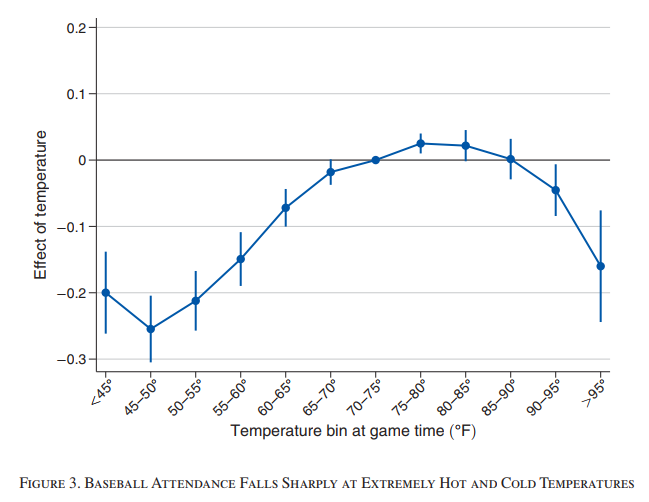The Value of a Cooler Day
The Willingness to Pay for a Cooler Day: Evidence from 50 Years of Major League Baseball Games
Published: American Economic Journal: Applied Economics 2025, 17(1): 126-59
with Kevin Kuruc and Melissa LoPalo
Paper draft available upon request.
Motivation
A large body of economic literature documents the severe impacts of extreme temperatures on critical outcomes like mortality, productivity, and GDP. However, one widely experienced but less-studied effect is the loss of well-being due simply to the discomfort of being outdoors on very hot or cold days. While potentially small at the individual level, the universal nature of this experience suggests that the aggregate welfare effects could be substantial.
This paper provides a monetized estimate of the disutility of extreme temperatures by examining how consumer choices change in response to weather.
Approach
We use Major League Baseball (MLB) games as a setting to isolate and value the disutility of uncomfortable weather. The rich, century-long record of attendance provides substantial variation in game-day weather across different local climates. Our analysis proceeds in two main parts.
Attendance and Revealed Preference (1950-2000): We first use a dataset of over 80,000 MLB games to estimate the causal impact of temperature on attendance. Our empirical strategy identifies the effect of unusual weather for a given stadium and month, controlling for factors like team popularity, day of the week, and stadium-specific seasonality. We then translate this estimated decline in attendance into a monetary value. This step leverages two key historical features of the primary market for baseball tickets:
Fixed Pricing: Teams historically set ticket prices for the season, meaning prices did not adjust to short-term demand shifts (like those caused by weather), implying a horizontal supply curve.
Inelastic Demand: A robust finding in the sports economics literature is that teams priced tickets in the inelastic portion of the demand curve. We use a central price elasticity estimate of 0.7 from this literature.
With these assumptions, a measured decline in attendance (a leftward demand shift) can be converted into the equivalent price decrease needed to counteract that decline.
Secondary Market Prices (2021): As a second, complementary approach, we analyze modern ticket price data scraped from SeatGeek, a secondary market, for the 2021 MLB season. In this market, prices are dynamic and respond to real-time demand. This allows us to directly estimate the change in willingness to pay by observing how ticket prices fall on very hot or cold days.
Key Findings
Extreme weather significantly reduces MLB attendance. Attendance falls by 16% at temperatures above 95°F and by 20-25% on days below 55°F, relative to a mild 70-75°F day. A placebo test confirms this effect disappears for games played in domed or retractable-roof stadiums, indicating the decline is driven by spectator discomfort, not other factors.
(The figure below shows the main regression results, plotting the percentage change in game attendance for each 5-degree temperature bin relative to the 70-75°F bin.)

The decline in attendance on hot days implies a significant change in fans’ willingness to pay. Our estimates suggest the marginal fan’s willingness to pay drops by $4.11 for a game played in >95°F heat.
This translates to an hourly disutility of $1.53 per hour for exposure to temperatures above 95°F and $1.93 per hour for exposure below 45°F.
The analysis of modern secondary market data validates these findings. On SeatGeek, ticket prices in 2021 fell by 8.4% on days over 90°F. When the historical attendance data is restricted to a comparable sample, the monetized disutility estimates from both methods align closely.
Aggregate Implications
Extrapolating our hourly disutility estimate suggests nontrivial aggregate welfare effects from climate change. Under a business-as-usual climate scenario, the increased frequency of very hot days could generate an annual welfare loss from discomfort of approximately $2.31 billion by the end of the century in the U.S.. While this figure does not fundamentally alter estimates of the social cost of carbon, it is comparable in magnitude to the largest weather disasters experienced annually, highlighting that the simple discomfort from heat represents an economically meaningful cost of climate change.
